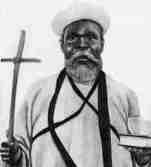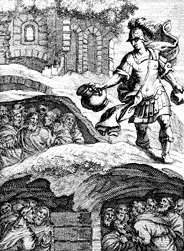 W
WThe Apocalypse of Elijah is an anonymous apocryphal work presenting itself as a revelation given by an angel. Two versions are known today: a Coptic Christian fragmentary version and a Hebrew Jewish version. The title derives from mentions of Elijah within the text, although there is no other reason to assume that he is meant to be the author.
 W
WBaal, properly Baʽal, was a title and honorific meaning "owner", "lord" in the Northwest Semitic languages spoken in the Levant during antiquity. From its use among people, it came to be applied to gods. Scholars previously associated the theonym with solar cults and with a variety of unrelated patron deities, but inscriptions have shown that the name Baʿal was particularly associated with the storm and fertility god Hadad and his local manifestations.
 W
WThe Cave of Elijah is a grotto that appears in the Hebrew Bible, where the prophet Elijah took shelter during a journey into the wilderness.
 W
WThe statue of Elijah is a marble sculpture by Lorenzetto in the niche to the right of the entrance in the Chigi Chapel, the Basilica of Santa Maria del Popolo, Rome. The sculptor followed the original designs of his mentor, Raphael, who was the architect of the chapel. The statue was finished by his pupil, Raffaello da Montelupo.
 W
WElijah, Op. 70, MWV A 25, is an oratorio by Felix Mendelssohn depicting events in the life of the Prophet Elijah as told in the books 1 Kings and 2 Kings of the Old Testament. It premiered in 1846 at the Birmingham Festival.
 W
WElisha was, according to the Hebrew Bible, a prophet and a wonder-worker. Also mentioned in the New Testament and the Quran, Elisha is venerated as a prophet in Judaism, Christianity and Islam. Amongst new religious movements, writings of the Baháʼí Faith refer to him by name. His name is commonly transliterated into English as Elisha via Hebrew, Eliseus via Greek and Latin, or Alyasa via Arabic, and Elyesa via Turkish. He is said to have been a disciple and protégé of Elijah, and after Elijah was taken up in a chariot of fire, he gave Elisha a double portion of his power and he was accepted as the leader of the sons of the prophets. Elisha then went on to perform twice as many miracles as Elijah.
 W
WEliyahu Hanavi Synagogue is a synagogue in Alexandria, Egypt. It is located in Nabi Daniel street. Built in 1354, it was bombed by the French during their invasion of Egypt in 1798, and was re-built in 1850 with contributions from the Muhammad Ali Dynasty. It is included on the World Monuments Fund's 2018 list of monuments at risk.
 W
WWilliam Wadé Harris was a Liberian Grebo evangelist, who preached in Liberia, Côte d'Ivoire and Ghana. He has been described as the "most extraordinary one man evangelical crusade that Africa has ever known" and is considered one of the originators of today's prosperity gospel.
 W
WJohn the Baptist was a Jewish itinerant preacher in the early 1st century AD. Other titles for John include John the Forerunner in Eastern Christianity, John the Immerser in some Baptist traditions, and the prophet John (Yaḥyā) in Islam. He is sometimes alternatively called John the Baptizer.
 W
WJourneys With Elijah: Eight Tales of the Prophet is a 1999 children's picture book by Barbara Diamond Goldin and illustrated by Jerry Pinkney. It is based on the tradition that the biblical prophet Elijah can reappear to anyone anywhere at any time and is eight stories of people's encounters with him from ancient times to the modern day throughout the world.
 W
WNaboth was a citizen of Jezreel. According to the Book of Kings in the Hebrew Bible, he was executed by Queen Jezebel so that her husband Ahab could possess his vineyard.
 W
WObadiah is a character in 1 Kings in the Hebrew Bible. He was a majordomo in charge of Ahab's palace. According to 1 Kings 18:4, Obadiah hid a hundred prophets of God in two caves, fifty in each, to protect them from Jezebel, Ahab's wife. Later statements of the prophet Elijah, where he describes himself as the only remaining prophet of Yahweh led biblical theologian Otto Thenius to conclude that eventually they were captured and killed, but George Rawlinson and other commentators argue that Elijah means he is the only active prophet because the others are in hiding.
 W
WThe raising of the son of the widow of Zarephath is a miracle of the prophet Elijah recorded in the Hebrew Bible, 1 Kings 17, taking place in the Phoenician city of Zarephath.
 W
WSandalphon is an archangel in Jewish and Christian writings. Sandalphon figures prominently in the mystical literary traditions of Rabbinic Judaism and early Christianity, notably in the Midrash, Talmud, and Kabbalah.
 W
WTishbite is a demonym predicated of the Prophet Elijah in the Hebrew Bible. Scholars dispute the precise denotation of the word.
 W
WThe transfiguration of Jesus is a story told in the New Testament when Jesus is transfigured and becomes radiant in glory upon a mountain. The Synoptic Gospels describe it, and the Second Epistle of Peter also refers to it. It has also been hypothesized that the first chapter of the Gospel of John alludes to it.
 W
WIn the Book of Revelation, the two witnesses are two of God's prophets who are seen by John of Patmos, during the "Second woe" recorded in Revelation 11:1-14. They have been variously identified by theologians as two people, as two groups of people, or as two concepts. Dispensationalist Christians believe that the events described in the Book of Revelation will occur before and during the Second Coming. The two witnesses are never identified in the Christian Bible. Some believe they are Enoch and Elijah. as in the Gospel of Nicodemus, since they are the only two that did not see death as required by the Scriptures. Others believe them to be Moses and Elijah because they appeared during the transfiguration of Jesus, or because Enoch was not Abraham's descendant. Some also believe that they are Moses and Elijah due to the description of what they are to do. They have the power to shut the heavens (Elijah) and turn water into blood (Moses)